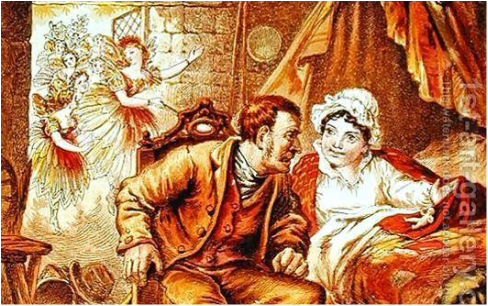|
Fairytales don't often give side characters names, but Tom's parents have occasionally received monikers. Occasionally.
In R.I.'s 1621 version, Tom's father is Old Thomas of the Mountain, a humble plowman who longs for a son. (His mother seems less involved; she goes along with it, but when she thinks Tom is lost, grieves for about a minute before getting over it.) In Tom Thumb's Folio: Or, a New Penny Play-Thing, for Little Giants (1810), Tom comes of nobler stock. His father is the more genteel-sounding Mr. Theophilus Thumb of Thumb Hall. Thumb is likewise used as a surname in Henry Fielding's parodic play. Here, Tom's father Gaffer Thumb comes back as a ghost. (Gaffer just means old man.) Charlotte Marie Yonge's History of Sir Thomas Thumb names his father Owen, but leaves his mother and crotchety old aunt unnamed. In Louisa Mary Barwell's Novel Adventures of Tom Thumb the Great (1838), Mrs. Thumb is related to the Fingers, a very old and respectable family. In Marianna Mayer's Adventures of Tom Thumb (2001), Tom's parents are Tim and Kate. In 1923, the Brooklyn Daily Eagle and the Detroit Free Magazine both printed a comic titled "Make-Believe," by Jane Corby. Here, Tom has a sister named Dotty. They set out for a picnic lunch in a carriage drawn by a mouse, with spools for wheels, but a cat sets upon them and then everything just gets progressively worse. In the Merrie Melodies short I Was a Teenaged Thumb (1963), the happy parents are "George Ebenezer Thumb and his wife Brunhilda." In the 1941 short Tom Thumb's Brother, his brother is named Peewee. In the 1958 film, Tom's parents are Jonathan and Anna, but this is really an adaptation of the Grimms' Thumbling. So in the majority, only Tom's father is named, and his name is some variation on Thomas, Sr. or Mr. Thumb. His mother has to wait for later adaptations to get a name. Interestingly, Tom's mother, unlike the mothers in other thumbling tales, isn't really as important as his father. In many thumbling tales, it's all about the mother's wish, her desire for companionship. The birth takes place independently of the father's involvement. The child is born in the kitchen, the mother's place of work, while the father is out and about farming; he may not even realize what's happened until his child brings him lunch in the field, and is puzzled to hear a voice calling him "Father." Sometimes, as in Thumbelina, there's no father at all. However, in the original Tom Thumb, the emphasis is on Old Thomas of the Mountain's wish for a son. The cases where they share a name emphasize this; although we see Old Thomas very little after the introduction, and we mainly see Tom interact with his mother when he falls into pudding or is eaten by a cow, he carries on his father's name. That can be Thomas or, more commonly, Thumb. Using Thumb as their real surname is an element of parody, but really does emphasize the theme of sons carrying on the family name and continuing the dynasty. Text copyright © Writing in Margins, All Rights Reserved
0 Comments
Leave a Reply. |
About
Researching folktales and fairies, with a focus on common tale types. Archives
July 2024
Categories
All
|
Writing in Margins

 RSS Feed
RSS Feed
